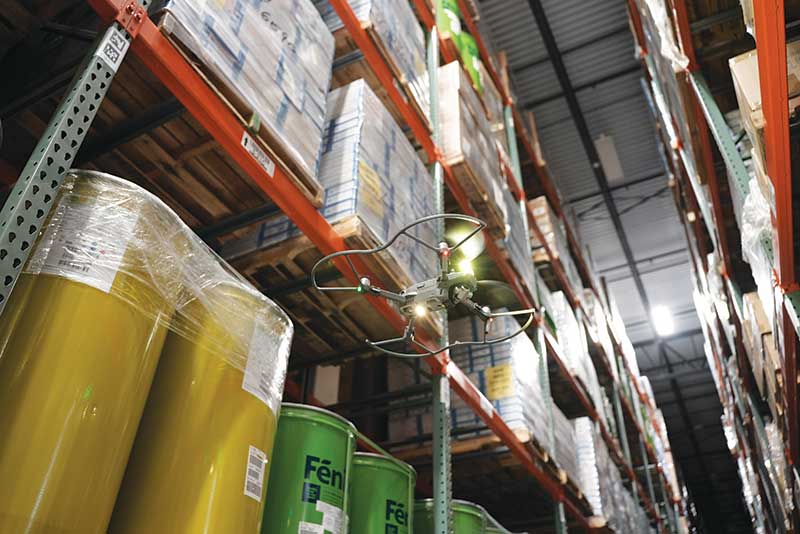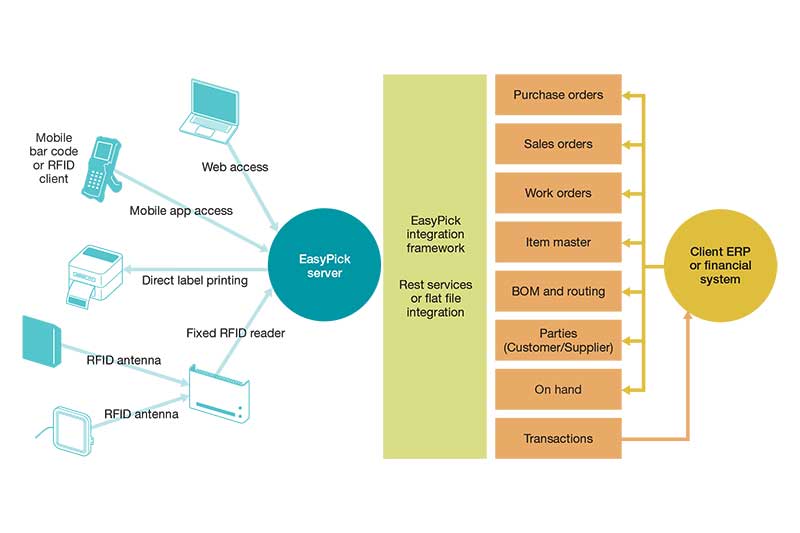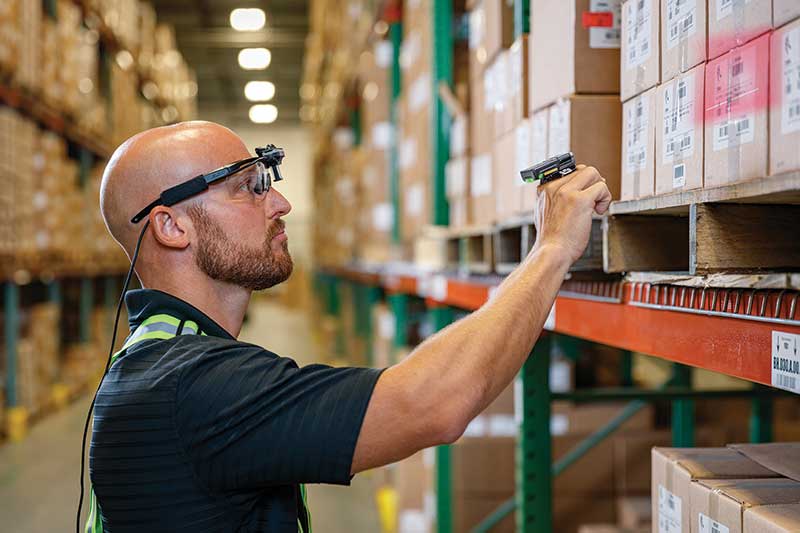Give Your Warehouse Management Systems (WMS) a Boost
New types of third-party software solutions can enhance WMS in many ways, including gains in inventory accuracy, better tools for creating workflows and user interfaces for task execution, and simplified integration with mobile robots and other forms of automation.

Warehouse management systems (WMS) remain the transactional and process management foundation for inventory control and order fulfillment in most DCs. In recent years, when Modern has surveyed readers about WMS use, close to 80% have told us they use some type of WMS.
That widespread adoption is because a well-implemented WMS will control inventory, and manage key processes like putaway, picking and replenishment.
But WMS doesn’t do everything well, especially older legacy systems that lack functionality like a labor management system (LMS) module, prebuilt connectors to automation, or flexible tools for creating new workflows. That’s giving rise to software solutions that make existing WMS solutions better.
These software vendors are focusing on new types of solutions that give WMS processes a boost, either by orchestrating multiple resources, building new workflows and screens for task execution, or simplifying the use of robotics. Here’s an overview of how they help.
Sequence and optimize
Keith Moore, CEO of AutoScheduler.AI, whose AutoScheduler warehouse resource planning and optimization software platform is touted as a “WMS accelerator,” says WMS is essential for governing DC processes, but WMS solutions typically lack the ability to optimize and plan all the machine and labor resources and material moves and staging to ensure orders get out the door complete.
In practice, adds Moore, many steps need to be synchronized, such as dock schedules, staging of pallets for outbound shipping, any new pallet builds or repalletizing that needs to take place, or any crossdocking that should be triggered, to achieve end goals.
Most WMS are not generating sequenced, optimized plans, notes Moore. Because of that, Moore says he likes the analogy that WMS—in terms of getting you to a goal—is like having a good, working car. A car will get you to your destination, but if all you have is a static, printed map for navigation, you might take a wrong turn or run into a traffic jam, fouling up your plans.
By contrast, Moore says, a mobile map app is both dynamic and instructive, which is why people today use both cars and mobile maps to get places efficiently.
Moore says:
“What was transformative about Google Maps is that instead of just telling you where to start and where to end, it was with you every step of way, so that even if you do make a wrong turn, it will tell you, ‘just take a U-turn here to get back on track.’ That is like what our solution does for warehousing. The software considers all the limitations and constraints that are going to keep you from getting to where you need be operationally and with service levels.”

Autonomous drones are visually striking, but much of their value lies in the accurate view of current inventory they provide, which can be leveraged to update WMS.
Orchestrating activities
The term “orchestration” gets used in several ways with warehouse-level software. One way is to orchestrate robotics with people and with other forms of automation, which has given rise to the category Gartner calls multi-agent orchestration (MOA) platforms, a complement to WMS.
However, orchestration happens on many levels, such as staging and loading pallets, directing pick-to-pallet activities, efficient crossdocks, and importantly, sequencing all those in the right order, explains Moore.
Says Moore:
“At the end of the day, top line revenue is driven by product that gets where it needs to go on time. Suppliers can get charged tens of millions in penalties for shipments that aren’t on-time and in full (OTIF), so being able to optimize all the activities that go into that carries high value.”
AutoScheduler’s resource optimization platform uses artificial intelligence (AI)-based logic to determine the best sequence of actions and allocation of resources to hit commitments.
Companies that have used the solution include P&G, which helped develop the software, and a major snack food manufacturer. A key focus for most users, adds Moore, is to improve fill rate. Even a 1% improvement in what Moore calls “controllable fill rate,” can add up to substantial savings in a year.

Inyxa’s EasyPick is a task execution solution that overlays a host system like an ERP solution.
Next up in focus for AutoScheduler is a network view of actionable metrics to improve fulfillment performance. Because the software already does resource planning for what needs to happen by site to meet order commitments, while also having a window into transportation and what is in the yard, AutoScheduler has developed and will soon introduce a dashboard solution for “Centralized Distribution Orchestration,” according to Moore.
The dashboard, which would highlight recommended actions, could be used across disciplines, Moore adds, such as by customer service managers to see if a delivery promise can be adjusted, if the software predicts a problem like an impending inventory shortage, or if unloaded trailers are starting to build up beyond an acceptable level, or, if there won’t be enough labor, or too much labor, over the short term. That provides time for adjustment, either on the customer service side, or perhaps a tweak to a transportation schedule, so a particular shipment gets routed to a DC that would otherwise be short.
Says Moore:
“Because we are optimizing for each site, and we know what we have to work with, and what we don’t have, we can predict what actions are going to help hit service level commitments for orders that won’t even start getting picked until the next day.”
While some WMS have orchestration features, most stop short of real-time coordination of details like which stretch wrapper a newly built pallet should be sent to. But the right overlay solution can optimize multiple processes and systems around all these steps that have to happen to get orders fulfilled on time, says Vishal Choudhari, practice director with Inyxa.
Choudhari says:
“What happens is that in many cases a company will go with our overlay solution because it goes beyond what standard WMS can provide. Those kinds of actions that involve logic and processes that go across systems are handled by us.”
Inyxa’s roots are as an implementation services provider for Oracle enterprise resource planning (ERP) projects. Over the years of working in that capacity, Inyxa developed software at the warehouse execution level to orchestrate a WMS or ERP system with automation such as automated storage and retrieval systems (AS/RS), while also providing front-end order picking functions for other parts of a warehouse, such as picking cases to a pallet.
While releasing orders down to an AS/RS may seem simple, Choudhari explains it can be complex to release orders that enforces inventory allocation rules and drives high utilization, but also releases work to the AS/RS in the order pallets need to be staged for shipment.
For example, in some industries, a company may want to allocate goods held in an AS/RS to specific customer or set limits on how large orders can be. Or, adds Choudhari, it might be that you want a rule that would allow a customer to receive an order early, if doing that saves on transportation.
Inyxa’s software also has check-in functions for receiving, and order picking functions, with the WMS getting updated as needed. “We trigger things in an ERP system, but many of the key interactions that the warehouse does, take place using the Inyxa system,” says Choudhari.
Users of Inyxa’s software include global pharmaceutical company Aurobindo, which Modern profiled in last November’s cover story. At Aurobindo’s DC in New Jersey, Inyxa’s software is used to release orders to the AS/RS and manage its inventory allocation rules, while providing front end tools for functions such as staging and loading.
Drawing on its software capabilities for larger enterprises, Inyxa also has developed a solution called EasyPick—a configurable mobile and web-based solution to direct materials handling workflows, such as order picking to carts or pallets, to directing which dock door a load should go to.
While EasyPick could be an extension to a legacy WMS, it can also be deployed as an order fulfillment solution that ties into a midmarket ERP, which might be all some organizations need versus WMS, says Choudhari. “The software provides an overlay that directs critical tasks, but it has some transactional capability as well, which allows some of our smaller customers to integrate it straight onto an ERP system like one from Sage, Epicor or NetSuite,” he says.

Solutions that simplify the creation of new workflows and mobile or wearable device execution screens can be a high-value extension to a WMS.
Robot-savvy workflows
Since fulfillment operations increasingly rely on a mix of fixed automation, human labor and mobile automation, a key trend in WMS-enhancing solutions are software platforms that handle creation of workflows and user interfaces for tasks that have frequent interplay between machine and labor resources.
This is more than traditional terminal emulation (TE) in the sense these newer add-ons may also feature some logic for pick path optimization or for synchronized handoff of goods between associates and autonomous mobile robots (AMR).
For example, in 2019, Zebra Technologies introduced FulfillmentEdge, software that wraps around a WMS to enable dynamic workflows and real-time, routing mobile workers for picking, packing and put-away. The solution also can be used to coordinate the movement of associates and AMRs, to support efficient collaborative picking.
When it comes to orchestrating WMS processes with AMRs and other forms of robotics, some WMS players have integration and orchestration capabilities, but so do third-party vendors that specialize in integrating robotics with WMS.
For instance, Roboteon recently emerged from stealth mode to launch its robotics fulfillment software platform. The solution uses pre-built adapters and gateways to streamline integration, and it also offers pre-built fulfillment workflows for tasks like picking and replenishment, and an orchestration engine to coordinate the flow of goods.
Dan Gilmore, Roboteon’s chief marketing officer, says the solution can extend what legacy WMS can do when it comes to quickly integrating with robotics and devising new and efficient workflows that span systems.
To fully optimize robotics processes, adds Gilmore, the solution can synchronize labor resource availability and location with AMR movements to specific nodes or points in the material flow.
Says Gilmore:
“Our robotics-assisted fulfillment becomes an enhancement to the WMS capabilities when it comes to warehouse automation with robotics. When the WMS passes information such as orders and tasks to our platform, Roboteon has a common user interface across multiple application screens to perform the work and pass back the information to the WMS. This approach facilitates WMS to optionally keep some segments of the work and pass robot-assisted fulfillment work to the fulfillment platform. This phased approach for brownfield warehouses or older WMS systems minimizes and mitigates the risks in implementation.”
Computer vision and sensors
Sensor-enabled solutions that boost WMS inventory accuracy are another trend. In particular, multiple vendors offer autonomous drones that feed data into AI-based software to gain a highly accurate view of inventory.
The beauty of an autonomous drone solution is that it can always be giving operations a highly accurate view of what is actually in the racks, and passing discrepancy data back to a WMS, without all the labor time and effort involved in manual cycle counts and hand scanning of labels, says Sean Mitchell, vice president of customer success with Gather AI, which offers a drone solution.
Says Mitchell:
“A WMS is only as valuable as the accuracy of the information. Our solution allows customers to conduct cycle counts 15 times faster than a human on a lift can. The increased counting volume ensures that discrepancies are fixed quickly, so the WMS truly reflects what is in the physical warehouse.”
With IdentPro’s real-time locating system (RTLS) and execution software, LiDAR and other sensors fitted to lift trucks are used to provide real-time positioning data, which helps improve inventory control, while feeding a digital twin of the warehouse to optimize pick paths and pallet transport missions.
Says Erik van Rikxoort, chief marketing officer for IdentPro:
“When you track and trace the forklifts, and you know what is on your forklifts, then when you move goods with a sensor enabled truck, you know exactly where those goods have been left. And with that, you’ve got a 100% visibility into both your fleet and your inventory, and error-free inventory accuracy, without scanning.”
A flat screen added to the cab is used to present a simplified, real-time map of the warehouse showing the operator’s next mission and route to take. “Every truck operator gets an optimized and updated map of the environment,” says van Rikxoort.

LiDAR and sensors on forklifts feed data into IdentPro’s software to provide real-time locating of all pallet placements and a digital twin view into where inventory sits.
Users of IdentPro’s solution include international brewer Asahi, as well as Warsteiner, another brewing company. According to van Rixoort, at Warsteiner, the system slashed turnaround times for loading trailers, from close to 40 minutes on average down to about 25 minutes, due to more efficient pallet staging and loading.
Most sites average a 20% to 25% gain in fleet productivity, he adds, enabled by the precise handle on inventory locations from the LiDAR sensors that pinpoint the location where pallets were placed to within 2.5 inches.
Van Rixoort says:
“Your operators don’t have to search anymore for missing inventory because we know exactly where everything was placed. If you are not using RTLS technology and an operator placed a pallet in the wrong rack and your verifications didn’t catch it to send an alert, forget about it—you’re going to be wasting time looking for inventory.”

Article Topics
AutoScheduler News & Resources
AutoScheduler.AI names Keith Moore as CEO Industry veteran Jeff Potts joins AutoScheduler as CRO Packaged goods company improves fulfillmentLatest in Materials Handling
IFR: robot installations by U.S. manufacturing companies up 12 percent last year Geek+ and System Teknik deploy PopPick solution for pharmacy group Med24.dk Beckhoff USA opens new office in Austin, Texas Manhattan Associates selects TeamViewer as partner for warehouse vision picking ASME Foundation wins grant for technical workforce development The (Not So) Secret Weapons: How Key Cabinets and Asset Management Lockers Are Changing Supply Chain Operations MODEX C-Suite Interview with Harold Vanasse: The perfect blend of automation and sustainability More Materials HandlingAbout the Author
Subscribe to Materials Handling Magazine

Find out what the world's most innovative companies are doing to improve productivity in their plants and distribution centers.
Start your FREE subscription today.
April 2024 Modern Materials Handling

Latest Resources










